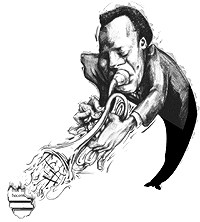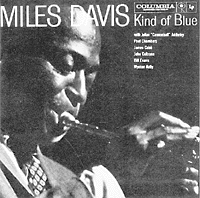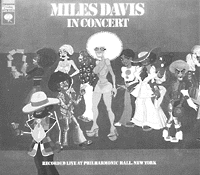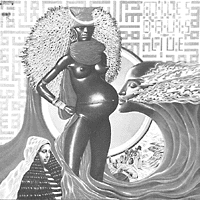Miles and Miles of Miles
The Columbia Legacy
By Jeff Mccord, Fri., Dec. 12, 1997
 Even in the very beginning, it was there -- a style. The clothes, the hair, and most of all, the sound -- the clear, rounded tone from the most expressive of instruments, the trumpet. From the moment this skinny, intense, overly-serious son of a prominent dentist from East St. Louis sat in with Billy Eckstine's band and watched Charlie Parker and Dizzy Gillespie slay the hometown audience, Miles Dewey Davis knew exactly what he had to do. Blow the horn. Soon, he was doing just that -- at Julliard by day, and at the University of Bird and Diz at night. Already living and breathing music, Davis, 19, was playing with the best: Parker, Gillespie, Thelonious Monk -- the kings of Minton's in Harlem and the uptown 52nd Street bebop scene, all big stars. Davis watched, listened, learned, all the while knowing his limits. He played only what he could handle, refusing to pander to the audience, and handled himself among these musical giants with style. It was only a matter of time before his popularity would eclipse them all.
Even in the very beginning, it was there -- a style. The clothes, the hair, and most of all, the sound -- the clear, rounded tone from the most expressive of instruments, the trumpet. From the moment this skinny, intense, overly-serious son of a prominent dentist from East St. Louis sat in with Billy Eckstine's band and watched Charlie Parker and Dizzy Gillespie slay the hometown audience, Miles Dewey Davis knew exactly what he had to do. Blow the horn. Soon, he was doing just that -- at Julliard by day, and at the University of Bird and Diz at night. Already living and breathing music, Davis, 19, was playing with the best: Parker, Gillespie, Thelonious Monk -- the kings of Minton's in Harlem and the uptown 52nd Street bebop scene, all big stars. Davis watched, listened, learned, all the while knowing his limits. He played only what he could handle, refusing to pander to the audience, and handled himself among these musical giants with style. It was only a matter of time before his popularity would eclipse them all.
It was all music then for Davis in postwar NYC, though the temptations of drugs and sex would soon follow. Seven years later, he would have to pull himself out of a tortuous four-year heroin addiction that nearly destroyed him personally and professionally. Landing back on his feet was not an easy task; he had been blacklisted from most every New York club. Hot new trumpet players such as Clifford Brown and Chet Baker were on the scene, and critics were beginning to write about Davis, now 26, as though he were washed up. Still, things were working in his favor.
|
|
Columbia Records.
Columbia would be Davis' home for the next 30-or-so years, and it's with this label he would make his greatest recordings and achieve his greatest fame. In his autobiography, Miles, an excellent read that must set a literary record for the use of the word "motherfucker" (his ultimate term of endearment), Davis laid out his philosophy:
"As a musician, I have always wanted to reach as many people as I could through my music. And I have never been ashamed of that. A lot of jazz musicians say in public that they would have to compromise their art to reach a whole lot of people. But in secret, they want to reach as many as they can. I always said that music had no boundaries, no limits to where it could go. Good music is good no matter what kind of music it is. And I always hated categories. Always. Never thought it had any place in music. In 1955, Columbia represented a doorway my music could go through to reach more listeners, and I went through that door when it opened up and never looked back."
Since Davis' death in 1991, Columbia has been slowly repairing his vast catalogue. Marred by deletions, the shrill digital reissues of the Eighties, and CDs hastily mastered from whatever source available, there was much in need of repair. The first ambitious project was 1995's 7-CD collection, The Complete Live at the Plugged Nickel 1965, featuring every note recorded (much of it previously unreleased) during a holiday stand at the historic Chicago club where Davis reunited his classic quintet -- Herbie Hancock, Ron Carter, Wayne Shorter, Tony Williams -- after a seven-month layoff for hip surgery. The performance, from one of the best bands Davis ever assembled, is riveting. The quintet is absolutely attuned to one another, playing at the top of their form.
In 1996 came an even more challenging and oft-delayed reissue project, The Complete Columbia Studio Recordings of Miles Davis and Gil Evans. Davis met Evans shortly after his arrival in New York, and they quickly discovered a kinship for carefully thought-out arrangements from a very schooled perspective. Evans became a confidant to Davis during his formative years, a voice he trusted. Their brief collaboration on Birth of the Cool would not be duplicated until Davis signed with Columbia, partly because the recording budgets at Prestige did not allow for projects of the scope the two had in mind. Davis made his second Columbia album with Evans, and Miles Ahead proved to be a welcome tonic for jazz fans whose ears had been blistered over the years by the ferociousness of bebop.
For the 6-CD box set, this heavily edited and overdubbed landmark was painstakingly reconstructed from the original master tapes for its first true stereo version. Phenomenal strides were made in the sound quality of all the material, with unreleased tracks and rehearsal segments included along with all four Davis/Evans collaborations: Miles Ahead, Porgy and Bess, Sketches of Spain, and Quiet Nights. While not Davis at his peak, these albums did offer the public something new, and the first three releases were remarkably successful.
Sketches of Spain proved to be an arduous and exhausting series of sessions, however; whether this dimmed Davis' enthusiasm for Quiet Nights will never be known for sure, but those sessions did end after only 20 minutes of material had been recorded. An ill-fitting quintet recording was included to round out the album, which was a flop with the public. Davis hated Quiet Nights and laid the blame on producer Teo Macero, causing a rift that took years to heal. Macero was not involved in this reissue project.
This year Columbia issued each of the Davis/Evans sessions on single discs, along with the improved sound and extra tracks, which while not containing all the music found on the box set, does provide an inexpensive way of obtaining some of Davis' best work. Plus, you don't have to fuss with the box set's beautiful but utterly impractical packaging.
 Along with the Davis/Evans single disc releases also came a "new" version of Kind of Blue, considered by many to be Davis' finest hour. The 1959 landmark marked a turning point, not just for Davis, but for jazz music in general. Two years earlier, Davis had recorded "Milestones," his first successful composition to be based on scale rather than chord structure. The modal form of playing offered limitless variety, and as the Fifties drew to a close, Davis finally had the band that was up to the task. In John Coltrane, he found an endlessly inventive soloist, while Cannonball Adderly was a more down-to-earth, solid blues-based player, whose fundamentals grounded some of Trane's loose-cannon tendencies. Pianist Bill Evans understood the modal approach from top to bottom, and Paul Chambers and Jimmy Cobb kept the rhythm solid.
Along with the Davis/Evans single disc releases also came a "new" version of Kind of Blue, considered by many to be Davis' finest hour. The 1959 landmark marked a turning point, not just for Davis, but for jazz music in general. Two years earlier, Davis had recorded "Milestones," his first successful composition to be based on scale rather than chord structure. The modal form of playing offered limitless variety, and as the Fifties drew to a close, Davis finally had the band that was up to the task. In John Coltrane, he found an endlessly inventive soloist, while Cannonball Adderly was a more down-to-earth, solid blues-based player, whose fundamentals grounded some of Trane's loose-cannon tendencies. Pianist Bill Evans understood the modal approach from top to bottom, and Paul Chambers and Jimmy Cobb kept the rhythm solid.
For the Kind of Blue sessions, Davis brought in only the sketchiest blueprints of the songs, the septet working them out in the studio; according to Bill Evans, the first complete run-through is more often than not the version you hear on the album. Why the "new" reissue? For one, the album's original warmth has been restored by reprocessing the sound through tube equipment. More importantly, perhaps, three tunes that were originally mastered at a slightly sharper speed have been corrected. Finally, an alternate take of "Flamenco Sketches" has been included.
This off-speed mistake has been on every version of this album except an expensive gold "Mastersound" CD from a couple of years back, so a warning to the pitch-sensitive who have grown up listening to this classic: The first time you hear the "new" Kind of Blue it is somewhat jarring. As for the music, if ever an album was essential, this is it. A band this talented was doomed to splinter; in fact Evans had already quit the band, but agreed to come back to make the album. Two weeks after this session, Coltrane, using the same modal approach, went into the studio and recorded Giant Steps.
Also this year, Columbia/Legacy imported 28 titles of the Davis catalogue from Japan, available as limited editions in sleeves designed to represent miniature album covers. Included are several titles not currently available in America: Miles in Tokyo, a 1964 quintet date pre-Wayne Shorter with Sam Rivers on the saxophone; Star People and We Want Miles, studio and live recordings respectively from the early Eighties (both better than average releases from Davis' late period); and Get Up With It, Davis' last studio recording before his "retirement" of 1975-81, featuring his tribute to Duke Ellington, "He Loved Him Madly." The fidelity on these Japanese versions is often better than their American counterparts, especially Eighties-era digital reissues. They have no extra tracks of any kind, however, and Columbia has plans to upgrade the entire catalogue (including bonus tracks) for the U.S. in the next couple of years.
This year's final Davis reissues all date from the period of 1970-74. While his recordings on Columbia continued to be more innovative until the latter half of the Sixties, Davis' playbook changed remarkably little; one show was pretty much like any another -- "My Funny Valentine," "'Round Midnight," "Milestones." Albums as groundbreaking as Nefertiti and Filles de Kilimanjaro were being ignored in the live arena, and his classic quintet of Hancock, Carter, Shorter, and Williams was getting restless to play the new tunes. As a matter of fact, the whole country was getting restless.
While Davis' quintet, dressed sharp in their suits and ties, continued playing their superlative sets to ever dwindling audiences, the country was in upheaval. Already, James Brown, Jimi Hendrix, and Sly & the Family Stone had supplanted jazz as America's popular music, and all were people who would radically alter Davis' thinking during this period. One musician in particular who changed Davis' mind about a lot of things was drummer Tony Williams.
A musician for which Davis had infinite respect, Williams joined the quintet when he was only 17 and began stating his opinions right away -- opinions that differed from those of a boss many decades his elder. Turning Davis on to Ornette Coleman, Williams also persuaded him to try out Archie Shepp and Sam Rivers, and was instrumental in getting Wayne Shorter into the band.
Then, in 1968, Davis met and married singer-songwriter Betty Mabry. Mabry introduced Davis to the music of Hendrix, which opened Davis' eyes to the music of the day. Davis had already been flirting with electric instruments in the studio, but by 1968 and the release of In a Silent Way, there was no turning back. Columbia's new president, Clive Davis, who came from a rock & roll background and was unhappy with Davis' carte blanche to take advances against his royalties whenever he felt like it, was happy to see Davis leaning in a more electric direction. He was even happier when Bitches Brew became the biggest selling Miles Davis album ever.
Davis' new sound was utterly contemporary; in fact, 20 years later, it still sounds modern. Only Shorter was left from the quintet by this time, and Davis began using an ever-increasing stable of musicians for his concerts, which had become nonstop electric marathons, weaving in works from the recent albums. Chick Corea, Keith Jarrett, Jack DeJohnette, Dave Holland, Wayne Shorter, Dave Liebman, John McLaughlin, Billy Cobham, Joe Zawinul, Al Foster, Billy Hart -- the list went on and on -- and for the first time, a stint with Davis was not a guarantee of a career thereafter.
Davis would let his bands play until he felt it was time to move on, at which point he would cue them by playing the first few notes of the next tune. Many players began to come from rock and funk backgrounds, and Davis just threw them into the mix with first-rate jazz players and let them fend for themselves. The results ranged from galvanizing to horrific, and of course the critics and many of his peers turned on Davis with a vengeance. Ignoring them all, the albums kept coming, including the criminally overlooked soundtrack to Jack Johnson, and a slew of live recordings, five of which Columbia has re-released as double CDs.
Black Beauty is the earliest and worst of the lot, an album Davis didn't want released (until now it was only available in Japan). Nothing gels in this early 1970 show; the sound is horrible, Corea and Holland seem lost, and Steve Grossman frantically blows distorted scales throughout. Faring much better is Live Evil, a downbeat but fascinating live/studio collage with a huge cast of players, and Miles Davis at Fillmore, recorded over four nights at the Fillmore East, with each night being edited down to fit one of the album's four sides. Much of the material is from Bitches Brew, though it's often rendered almost unrecognizable. The playing is much more cohesive, but on both albums Teo Macero's ham-fisted editing is hard to ignore.
 Just as hard to ignore is Davis' love of the wah-wah, which he used ad nauseam on In Concert, recorded live at Philharmonic Hall. By now, most of the jazz players had been supplemented by rock and soul musicians. There are some real moments here, some nice ballad work by Davis and saxophonist Carlos Garnett, and a superb treatment of "Black Satin." Two years later, however, Davis was in bad shape. Aside from his hip giving him constant pain, he broke both ankles in a car accident in late 1972. His general health was deteriorating rapidly, and he was months away from his self-imposed retirement period.
Just as hard to ignore is Davis' love of the wah-wah, which he used ad nauseam on In Concert, recorded live at Philharmonic Hall. By now, most of the jazz players had been supplemented by rock and soul musicians. There are some real moments here, some nice ballad work by Davis and saxophonist Carlos Garnett, and a superb treatment of "Black Satin." Two years later, however, Davis was in bad shape. Aside from his hip giving him constant pain, he broke both ankles in a car accident in late 1972. His general health was deteriorating rapidly, and he was months away from his self-imposed retirement period.
All of this makes Dark Magus, recorded at Carnegie Hall in 1974 and previously only released in Japan, even more of a surprise. Saxophonist Azur Lawrence and David Liebman spar to great effect, and guest guitarist Dominique Gaumount keeps second guitarist Reggie Lucas on his toes as well. The music is fiery. Given the place and time, an amazingly vital performance.
And the Miles Davis reissue program continues. Early next year, there will be a box set of Davis' amazing Sixties quintet that gathers all the performances chronologically for the first time. Like the Plugged Nickel and Gil Evans box sets, this collection will be produced by Columbia/Legacy in conjunction with the folks at Mosaic, who offer the vinyl through mail order (203/327-7111). It's good to see such a rich musical legacy getting the treatment it deserves.
Miles Davis was smart, talented, a quick learner, and an expert teacher. He was also arrogant, obstinate, and far from perfect. Nevertheless, few musicians in any genre have managed to make and influence modern music to his degree. He handled things in his own way, in his own brusque, sharp, and inimitable style. He never hammed it up for an audience, or played a note of music he didn't believe in. And in so doing, he left the world his greatest gift.







